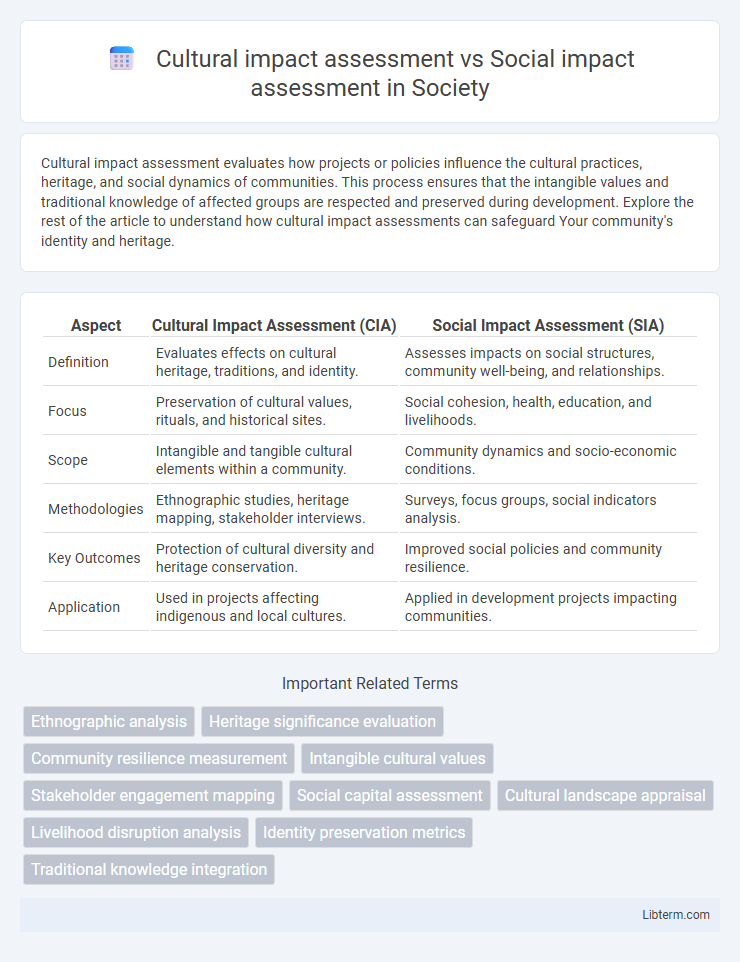Cultural impact assessment evaluates how projects or policies influence the cultural practices, heritage, and social dynamics of communities. This process ensures that the intangible values and traditional knowledge of affected groups are respected and preserved during development. Explore the rest of the article to understand how cultural impact assessments can safeguard Your community's identity and heritage.
Table of Comparison
| Aspect | Cultural Impact Assessment (CIA) | Social Impact Assessment (SIA) |
|---|---|---|
| Definition | Evaluates effects on cultural heritage, traditions, and identity. | Assesses impacts on social structures, community well-being, and relationships. |
| Focus | Preservation of cultural values, rituals, and historical sites. | Social cohesion, health, education, and livelihoods. |
| Scope | Intangible and tangible cultural elements within a community. | Community dynamics and socio-economic conditions. |
| Methodologies | Ethnographic studies, heritage mapping, stakeholder interviews. | Surveys, focus groups, social indicators analysis. |
| Key Outcomes | Protection of cultural diversity and heritage conservation. | Improved social policies and community resilience. |
| Application | Used in projects affecting indigenous and local cultures. | Applied in development projects impacting communities. |
Introduction to Impact Assessments
Cultural impact assessment evaluates the effects of projects or policies on the heritage, traditions, and identity of specific communities, emphasizing the preservation of cultural resources and practices. Social impact assessment focuses on the broader social consequences, including changes to community structures, livelihoods, health, and well-being. Both methodologies are essential tools in impact assessments, ensuring that development initiatives respect and integrate the needs and values of affected populations.
Defining Cultural Impact Assessment (CIA)
Cultural Impact Assessment (CIA) evaluates the effects of projects or policies on the cultural heritage, practices, and values of communities, emphasizing the preservation of cultural identity and intangible cultural assets. Unlike Social Impact Assessment (SIA), which broadly considers social well-being, infrastructure, and community dynamics, CIA specifically targets cultural expressions, sacred sites, and traditional knowledge systems. Integrating CIA into planning processes ensures culturally sensitive decision-making that respects indigenous populations and minority groups.
Defining Social Impact Assessment (SIA)
Social Impact Assessment (SIA) systematically evaluates the consequences of development projects on the well-being, social structures, and livelihoods of affected communities. It emphasizes stakeholder engagement, community health, economic conditions, and social cohesion to ensure sustainable development outcomes. Unlike Cultural Impact Assessment, which centers on cultural heritage and identity, SIA provides a broader analysis of social dynamics and human factors.
Key Differences Between CIA and SIA
Cultural Impact Assessment (CIA) primarily evaluates the effects of projects on cultural heritage, traditions, and identity, while Social Impact Assessment (SIA) focuses on the broader social consequences, including community well-being, livelihoods, and social structures. CIA emphasizes intangible cultural values and preservation of indigenous knowledge, contrasting with SIA's broader analysis of demographic changes, social cohesion, and stakeholder engagement. The methodologies in CIA often involve ethnographic studies and cultural mapping, whereas SIA relies on social surveys and impact modeling to assess community dynamics.
Methodologies in Cultural Impact Assessment
Cultural Impact Assessment (CIA) methodologies emphasize qualitative approaches such as ethnographic studies, participatory mapping, and stakeholder interviews to capture community values, traditions, and heritage. These methods prioritize local knowledge and cultural expressions, ensuring that intangible cultural assets are identified and preserved. In contrast, Social Impact Assessment (SIA) often uses a blend of quantitative surveys and demographic analysis to evaluate broader social changes, but CIA's focus on nuanced cultural dimensions requires deep engagement with cultural practices and symbolic meanings.
Methodologies in Social Impact Assessment
Social Impact Assessment (SIA) methodologies emphasize participatory approaches such as stakeholder consultations, surveys, and focus groups to identify and evaluate social consequences of projects or policies. Quantitative methods like demographic analysis and social indicator tracking are combined with qualitative techniques like ethnographic studies and narrative analysis to capture changes in community cohesion, health, and livelihoods. Cultural Impact Assessment, by contrast, incorporates ethnographic methods but places stronger emphasis on intangible cultural heritage, traditions, and identity, often overlapping with SIA but requiring specialized cultural expertise.
Case Studies: CIA vs SIA Applications
Case studies demonstrate that Cultural Impact Assessment (CIA) primarily addresses the preservation of indigenous heritage and traditional knowledge, as seen in projects like the Belo Monte Dam in Brazil, where CIA highlighted risks to local tribes. Social Impact Assessment (SIA) focuses on broader community effects, including displacement, health, and economic factors, exemplified by the expansion of the Gautrain project in South Africa, where SIA guided policy on resettlement and employment. Comparing these applications underscores CIA's role in safeguarding intangible cultural assets, while SIA provides a framework to manage socio-economic transformations.
Challenges in Conducting CIA and SIA
Conducting Cultural Impact Assessments (CIA) often faces challenges such as accurately capturing intangible cultural values and traditions, obtaining community trust, and dealing with diverse stakeholder perspectives. Social Impact Assessments (SIA) confront difficulties in measuring social changes, addressing potential conflicts among affected groups, and ensuring inclusive participation throughout the process. Both CIA and SIA require robust methodologies to handle complex qualitative data and mitigate biases in stakeholder engagement.
Integrating CIA and SIA in Project Planning
Integrating Cultural Impact Assessment (CIA) and Social Impact Assessment (SIA) in project planning ensures comprehensive evaluation of both cultural heritage and community well-being, enhancing sustainability and stakeholder engagement. Combining CIA's focus on intangible cultural values with SIA's emphasis on social structures and livelihoods allows for more nuanced mitigation strategies that respect local traditions while addressing socioeconomic changes. Effective integration requires interdisciplinary collaboration and early stakeholder consultation to align project objectives with cultural preservation and social equity goals.
The Future of Cultural and Social Impact Assessments
The future of cultural and social impact assessments emphasizes integrating advanced data analytics and community-driven methodologies to enhance accuracy and inclusivity. Emerging trends highlight the importance of real-time monitoring and adaptive frameworks that respond dynamically to cultural nuances and social changes. Technological innovations, such as AI and geospatial mapping, are set to transform how these assessments predict, measure, and mitigate impacts on diverse populations and heritage.
Cultural impact assessment Infographic

 libterm.com
libterm.com